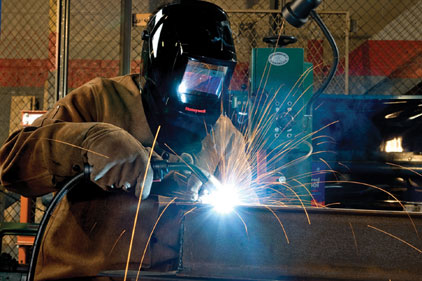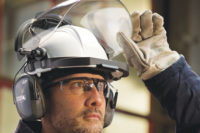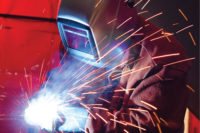OSHA requires the elimination of hazardous conditions in the workplace. When hazards cannot be eliminated through engineering or limited worker exposure, safety managers must rely on personal protective equipment (PPE) to guard employees against injury or other ill effects.
A typical welding operation presents hazards such as harmful radiation from electric arc welding; thermal burns on exposed skin from sparks and spatter; fumes and gases from materials used in the welding process; airborne slag chips, grinding fragments and similar debris from cleaning and finishing; and noise hazards from the “sizzle” of the arc through grinding.
More than half of all welding-related injuries affect the eyes and face, according to the BLS. Leading reasons for these injuries include workers not wearing protective equipment despite its availability and workers wearing protective devices that are inadequate for their needs, according to the American Welding Society.
The cost of noncompliance with proper eye and face protection is significant. Eye injuries alone cost U.S. businesses an estimated $924 million annually in direct costs such as medical bills and workers’ compensation, and up to $4 billion per year in lost wages and production, according to the BLS. Yet, experts agree that an estimated 90 percent of these injuries could be prevented through the use of appropriate PPE.
Given the high frequency and expense of welding-related eye and face injuries, corresponding PPE should be carefully selected, yet it often receives the least amount of attention. Safety managers do not always know how to determine which PPE is suitable for their workers’ needs. This article serves to inform safety managers of the types of eye and face protection available for welding applications to support these crucial decisions and best protect the workforce.
Welding helmets
Welding helmets and goggles are standard forms of PPE for most welding operations. All other protective equipment is added to or worn in conjunction with helmets or goggles to enhance protection against a specific combination of hazards. A welding helmet provides a barrier between the eyes and face and the myriad hazards of welding. Its primary function is to prevent arc radiation, sparks and welding spatter from striking the face, neck and head. The front of the helmet holds a filter plate that filters out dangerous ultraviolet and infrared radiation. The degree of filtration is prescribed by the ANSI-Z.87-1 Face and Eye Protection Standard and is referenced by a shade number.
When evaluating welding helmets, choose the material and shape of the helmet and visor for the appropriate welding process, working conditions and environment. Look beyond the obvious: check for the grade of raw material, reinforcement in known areas of wear, and simplicity and reliability of moving parts. Determine the availability of replacement parts and accessories to help reduce overall cost and extend the helmet's versatility.
Welding helmet comfort is delivered through the headgear, the only part of the helmet that actually comes in contact with the wearer’s head. Headgear helps to balance and stabilize the weight of the helmet over the widest possible area of the head. The headband should be designed to grip deeply on the nape of the head and should be adjustable in small increments to allow the wearer to achieve a comfortable, individual fit.
Goggles and spectacles
A BLS study of welding-related eye and face injuries showed that welders suffered eye injuries of various types despite wearing welding helmets. This contributed to the provision in the most recent ANSI-Z87.1 standard that requires basic eye protection, such as spectacles and goggles, to be worn in addition to a welding helmet.
If injury statistics at your site reveal that eye injuries are caused by foreign objects striking the eyes, impact-resistant, clear-lens protection spectacles with side shields should be worn. If eye injuries are caused by radiation from other welders in the area or from reflections of arc light, protective spectacles with filter lenses — usually Shade 2 — and side shields should be worn.
Operators engaged in resistance welding, torch brazing, soldering, oxygen cutting and light-to-medium gas welding should wear welding goggles to protect from harmful radiation. A face shield should be worn over goggles to protect from thermal burns. There are two primary types of welding and cutting goggles. One type has dual 50-millimeter filter lenses and is worn directly over the eyes, while the other has a 2-inch by 4½ -inch filter plate holder and is usually worn over prescription safety spectacles.
Welding and cutting goggles, regardless of type, should have an impact-, abrasion- and flame-resistant frame, and an impact-resistant filter lens or plate in a filter shade suitable for the job. In addition, goggles should be lightweight and designed to provide a snug, but comfortable, fit. The surface that comes in contact with the skin should be non-allergenic, and ventilation should be indirect to allow air circulation while keeping heat, splash and radiation out.
Face shields
A welder is frequently exposed to hazardous high-impact flying particles from chipping, grinding or finishing operations. The proper protective equipment for these hazards is a face shield worn over approved safety eyewear. While face shields are designed to protect from high-impact flying objects, helmets are designed to protect from sparks, spatter and radiation. It is important to note that face shields and helmets are not interchangeable. A welding helmet should be exchanged for a face shield anytime grinding is required. Alternatively, auto-darkening filters that feature a grind mode will also provide sufficient protection for light grinding and weld cleanup work.
Face shields consist of a deflector, a window and headgear. Deflectors, which cover the forehead and head, should be made from sturdy, impact- and heat-resistant material and should have a completely smooth surface to deflect debris. Windows, which cover the face, should be impact-resistant, optically correct and dimensionally stable.
Next to the impact resistance of the window, the method by which the window attaches to the deflector is the most important protective feature of a face shield. Look for a simple method that provides a positive seal from dust, dirt and debris, as well as an attachment with locking cams to ensure the window does not dislodge. Worry-free PPE ensures that workers can focus on the job at hand, and not on fine-tuning fit or fixing or replacing protective gear.
By fully understanding the hazards each individual welder faces, as well as the latest eye and face PPE options for welding applications, employers can deliver the greatest protection to the workforce.






